Operation "Conrad"
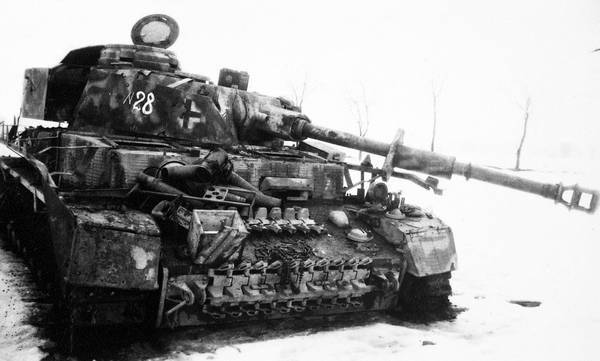
The siege of Budapest dragged on for a rather long time, primarily due to the fact that the main forces of the two Ukrainian fronts were connected by fierce battles with tank Wehrmacht connections that tried to unlock the Budapest group. After encircling the Hungarian capital, the German command carried out three operations, code-named "Konrad" (respectively, "Konrad I", "Konrad II" and "Konrad III"). All of them were aimed at releasing the blocked Budapest group and leveling the front along the Danube. To implement this plan, the German command transferred almost all the remaining reserves to Hungary. In Hungary, a huge number of selected armored units were concentrated, and it became a field of fierce battle.
At the same time, the German command was not going to simply pierce the corridor to Budapest and withdraw the surrounded troops from there. Hitler planned to send new troops to Budapest and continue the defense of the “Danube Stalingrad”. Hitler, first of all, was interested not in the support of the last friendly regime of Salash, but in the oil fields in the west of Hungary. Berlin was also worried that after the fall of Budapest, the road to Vienna opened. From the very first days of the battle for the capital of Hungary, the German Führer showed rare stubbornness and intractability. And although the command of Army Group South and the Hungarian military-political leadership did not attach much military importance to Budapest, offering to surrender it to level the front and preserve a large group of troops, Hitler categorically forbade even a retreat thought.
Already on the eve of the complete encirclement of Budapest (December 24 1944), Hitler sent additional forces to Hungary, including the SS 4 tank corps. Approximately 60 thousand soldiers and 200 tanks were sent to Hungary. The corps was commanded by the Obergruppenführer SS and the General of the SS troops Herbert Otto Gille. Gille previously commanded the Viking 5 Panzer Division, distinguished himself in rearguard battles after the failed German offensive near Kursk, led the German troops from the Korsun Cauldron, and distinguished himself in the defense of Kovel and in the battles near Warsaw. Gille was considered an expert in solving complex problems associated with the deblokadoy troops, and the 4-th tank corps showed itself well in battle. Therefore, Hitler and Himmler had high hopes for Gill.
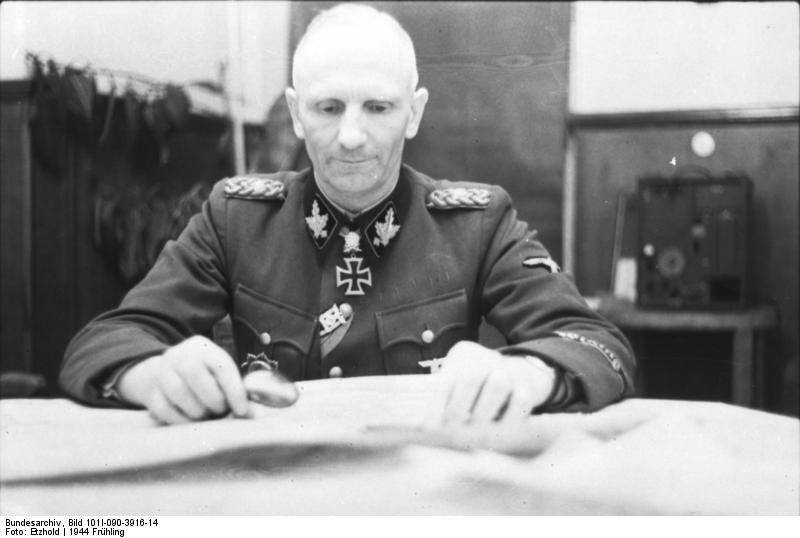
Commander of the 4 SS Panzer Corps Herbert Otto Gille
The command of the Wehrmacht solved the problem of where to strike the main blow. The plan, code-named "Paula", called for a strike in the south of Szekesfehervar. However, for the implementation of this plan, additional time was needed - 5 days and considerable reserves of fuel, since the armored vehicles would have to go a long way. An alternative was the “Conrad” plan when the main attack was carried out in the north. In this case, the regrouping of troops could be carried out faster, and such a large amount of fuel was not required. In addition, in the north it was possible to strike a sudden blow in order to be associated with the mountain-wooded terrain. In the south, a sudden blow was difficult. At first, the Chief of the General Staff of the Ground Forces, Guderian, was inclined towards the Paula plan, but changed his mind. Given the critical situation of the Budapest grouping, and the need to start the offensive before the Soviet troops entrenched themselves on the occupied lines, the army command finally settled on the Conrad plan.
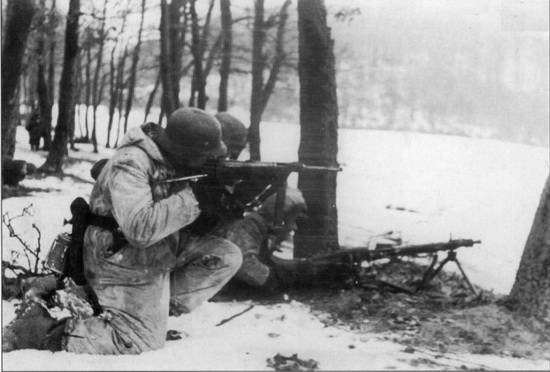
SS during Operation "Conrad"
It should be noted that some factors contributed to the German offensive. 4-I Zakharova Guards Army occupied the defense zone in 160 km. On the northern flank, the 31 Guards Corps occupied a lane in 48 km, the 68 Rifle Corps - 18 km, the 20 Guards Rifle Corps - 24 km, the 135 Corps - 16 km, the 21 Guards Corps - 20 km and about 35 km on the coast of. Balaton. The average number of rifle divisions of the 4 Guards Army was about 5,3 thousand people, which was about half the full-time strength. In addition, additional funds and forces were allocated to combat the remnants of the defeated German-Hungarian troops from the forests of the Wärtesheskheds mountains. As a result, Zakharov’s army could not create a solid defense.
Operation "Conrad I"
The German counteroffensive began in January 1945 from the region of Komarno. The German shock group began an incomplete operation. At the beginning of the attack, only about one third of the Viking SS Panzer Division 5, two thirds of the CC Dead Division, Dead Head, appeared in the initial positions, about half of the 3 infantry division, and the 96 infantry division had not arrived yet. The concentration of the 711 tank corps was completed only by January 4. The assault was also attended by the von Pape battle group, which included the main forces of the 8 National Grenadier Division remaining outside the Budapest “tank,” units of the Feldhernhalle Panzer Division, sent by the High Command from the reserve 271 Panzer Battalion (near 208 ” Panther "and tank destroyers" Hetzer ") and two of the three armored groups available in December (from the 50 and 6 armored divisions), as well as the Hungarian units. The German armored group then included: a tank battalion, a mechanized infantry battalion on a BRT, and an artillery regiment with units of self-propelled guns.
The beginning of the offensive was successful, but already on January 6 in the area of Bichke and Zambek, the Germans were stopped by Soviet troops. This was due to three factors. First, the tight deadlines for the preparation of a counter-attack adversely affected the state of the shock German grouping. By the beginning of the offensive, only a part of Gille's tank corps was concentrated. The rest of the troops were pulled up during the battle, which weakened the initial strike force of the corps. In addition, SS units experienced a shortage of armored vehicles, motor vehicles, which made the tank-grenadier regiments of the compound very conditionally motorized, as well as weapons (in particular, there were not enough machine guns). They did not manage to attract German tank formations assembled in Hungary, which were scattered in space on both banks of the Danube. The main forces of the 3 and 6 armored divisions were still located north of the Danube, and the 1 and 23 armored divisions defended under Szekesfehervarom and Mohr.
Secondly, the terrain conditions were convenient for organizing a sudden strike, but did not fit large armored formations. On the mountain communications it was easy to create defensive lines. Sometimes one anti-tank weapon could slow down the entire attack for a long time. And in mountain conditions to destroy a well-located firing point was extremely difficult.
Third, Tolbukhin and Malinovsky at the end of December 1944 were able to take a number of connections to the rear. As a result, the Soviet command in reserve had several tank, mechanized and cavalry corps, with a significant number of tanks and self-propelled guns. These reserves were enough to fend off an enemy offensive. So already 2 January 1945. 18-y tank corps entered the fight. Soon there were already five corps in the path of the German wedge. German offensive choked.
The commander of the Ukrainian Front 3, Tolbukhin, even overestimated the capabilities of the enemy, having excess forces in reserve. On the one hand, it tightened the siege of Budapest, on the other hand, the Soviet front received a large safety margin. Until the very end of the Budapest operation, the Soviet command retained free hand, unlike the Germans, who threw all their forces into the attack and did not have large reserves. In addition, Tolbukhin ordered the creation of special lines of defense on possible directions of breakthrough, paying special attention to anti-tank defense. On January 3, the storming of Buda was suspended.
During the first counter-offensive of the 4 tank corps, the headquarters of Army Group South offered to leave Pest and concentrate all forces to break out of the “boiler”. Even in the event of a general breakthrough, individual German and Hungarian units were given the opportunity to leave the encirclement in small groups. Particularly promising was the breakthrough to the north of Budapest, in the Pilish mountains. However, Adolf Hitler categorically rejected this idea.
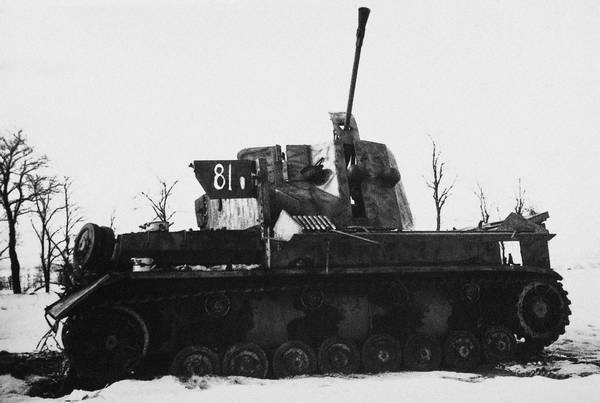
Anti-aircraft tank Flakpanzer IV "M" obelwagen "with 37-mm cannon Flak 43, captured by the Red Army in good repair in the suburbs of Budapest
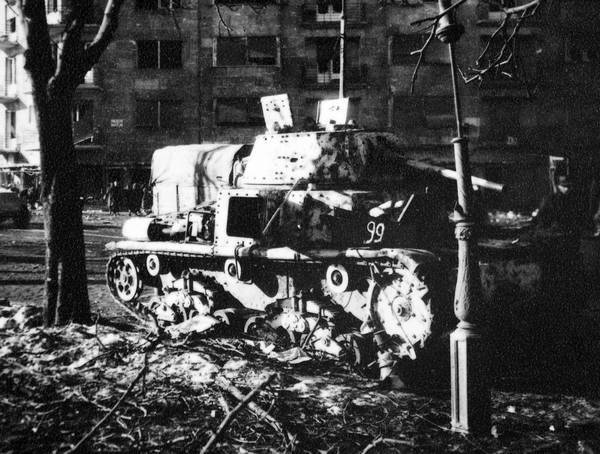
Soviet captured captured Italian tank M15 / 42, used by German units during the fighting in Budapest
Operation Conrad II
The offensive of the 4 SS Panzer Corps did not lead to quick success, so the German command decided to return to the "southern" plan. The Soviet Defense between Mohr and Szekesfehervar was supposed to break through the Bright armored group: 1, 3, 23 tank divisions, 503 heavy tank regiment (Tigers were armed) and 4 Cavalry brigade. The German group had about 120 tanks and SPG. The command of Army Group "South" hoped not only to unblock Budapest, but also by joint efforts of two strike groups to surround a significant part of the Soviet troops on the western slopes of the mountains, and then restore the front on the Danube.
The movement of the German troops in time discovered, so the 20-th Guards Rifle Corps, which was located in the place of the future strike, had time to strengthen, especially with artillery. In addition, another 6 January launched an offensive army 2-th Ukrainian Front - 7-I Guards Army and 6-I Guards Tank Army. Our January 8 troops reached out to Komarno, that is, to the operational rear base of the 4 tank corps. It turned out that the Germans were swept from the flank, and the SS 4 corps had to solve another problem.
The German offensive began on January 7 1945. However, the Soviet resistance was so strong that all German counterattacks were unsuccessful. Soon the Soviet 7 th mechanized corps (around 70 tanks and self-propelled guns) launched a counter-attack against the enemy and the area of the city of Zamoi turned into a tank cemetery. By January 11 the battle was over. Both sides suffered heavy losses, but did not succeed.
In the meantime, the SS 4 tank corps continued to burst toward Budapest. The Germans, after unsuccessful attempts to break through the Soviet defenses in the Bicke area, shifted the center of their strike north, under the Gran and Szentendre. By January 11, the SS Westland Grenadier Regiment of the Viking Division was only 21 km from Budapest. The command of Army Group "South" requested the High Command to begin breaking through the encirclement ring from within. Part of the Budapest group, abandoning heavy weapons, could well be saved. General Wenk, at the request of the headquarters of Army Group South, tried for two hours to convince Adolf Hitler that Budapest had to be left, and the surrounded group to go ahead, regardless of the losses. However, Hitler did not give permission, he wanted to keep Budapest, and not to withdraw the remnants of the garrison. Therefore, on January 12, unable to continue the offensive and being threatened by the environment (the threat of the Pilish bag), the advanced units of the German corps began to withdraw. At this time, the advanced units of the Viking division were in 17 km from the Hungarian capital.
On January 11, Hitler issued an order to regroup the 4 SS Panzer Corps; now he had to transfer the center of his strike to the north-western shores of Lake Balaton. During the day, Hille tried to convince the high command of the advisability of continuing the offensive in the north, where there was already success. However, in the evening came a repeated order to regroup the troops. 12 January Gille gave the order to retreat.
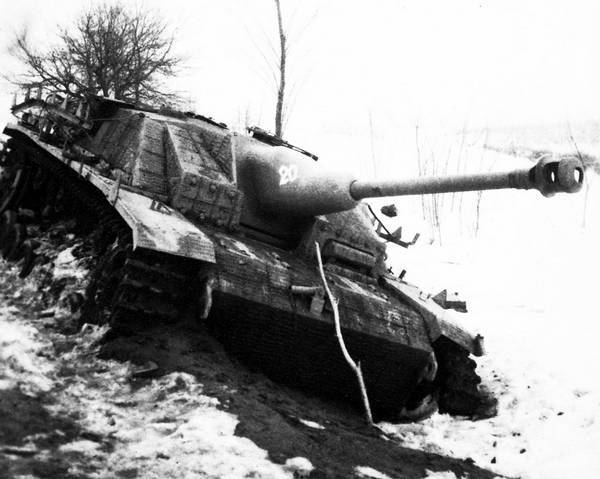
A stuck assault gun StuG 40. Lake Balaton District
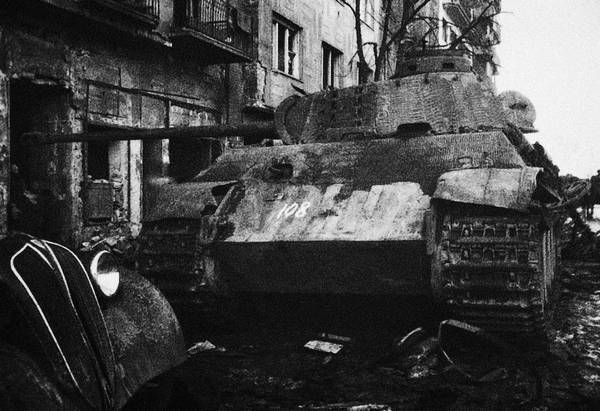
Tank Pz.V "Panther", shot down during the fighting on the streets of Budapest
Operation Conrad III
By 17 in January, units of the 4 SS Panzer Corps were transferred to the territory between Lake Balaton and Szekesfehervar in strict secrecy. The German group consisted of about 300 tanks and SPG. January 18 The Germans attacked the positions of the Soviet troops. The German command planned to reach the Danube in the Dunapepele area, thereby breaking the link of the Soviet troops along the Danube, and then developing an offensive northward to Budapest and southward. With the success of the operation, SS tank formations should have freed the Budapest group and restored the front along the Danube.
Reconnaissance of the 4th Guards Army missed a regrouping of German troops, so the attack was sudden. The Germans, despite the counterattack of the 7th mechanized corps, broke through the Soviet defense and already reached the Danube in the Dunapetele region on January 19. In Soviet battle formations, even for some time chaos was established. German aviation bombed the crossing of the Danube. The 133rd Rifle and 18th Panzer Corps were temporarily surrounded. However, the Germans had few infantry, so they almost immediately left the encirclement and joined in the liquidation of the breakthrough. On January 21, pontoon bridges over the Danube were blown up in the areas of Dunapelete and Dunaföldvar.
January 22 after a long and fierce fighting the Germans took Szekesfehervar. On January 24, the “Dead Head” division occupied the southern part of Barachka, a settlement that was located 30 km from the Hungarian capital. By January 26, the German forces were able to get closer to Budapest on 25 km. On this success of the German troops ended.
The Soviet command rather quickly took measures to repel an enemy strike. Through the Danube, despite the intensification of German bomber aircraft, it was possible to transfer considerable forces. South-west of Budapest, they created a powerful line of defense that the Germans could not overcome. 27 January Soviet troops launched a counter-offensive. The German wedge was very vulnerable from the northern and southern flanks. From the south, troops of the 57 Army, units of the 133, 30 and rifle and 18 tank corps attacked. From the north, the 23 tank and 104 rifle corps advanced. German troops turned defensive and stubbornly resisted. However, they were forced to leave all the occupied territories, except for Szekesfehervar. After a stubborn battle, Soviet troops were able to occupy only the northern part of Szekesfehervar.
Thus, the operation "Conrad" ended unsuccessfully for the Germans. German armored formations could not completely liberate Budapest, defeating the Soviet troops and reestablishing the position of the front on the eve of Christmas 1944 of the year (maximum plan), or simply to withdraw the garrison of Budapest from the city. However, Hitler did not accept failure. Not hoping to unblock the Budapest grouping, which was already written off at headquarters of Army Group South, the German command still hoped to keep the western part of Hungary. Therefore, in late January, 1945 was ordered to transfer troops to the 6 th SS tank army in Hungary.
To be continued ...
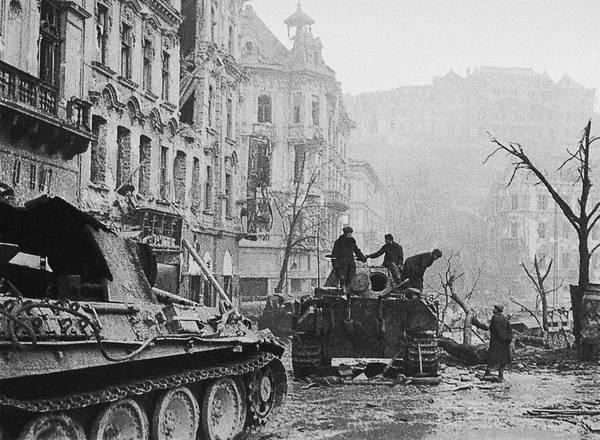
Broken German tanks Pz.V Ausf.G "Panther" in the street of Budapest. February 1945 of the year
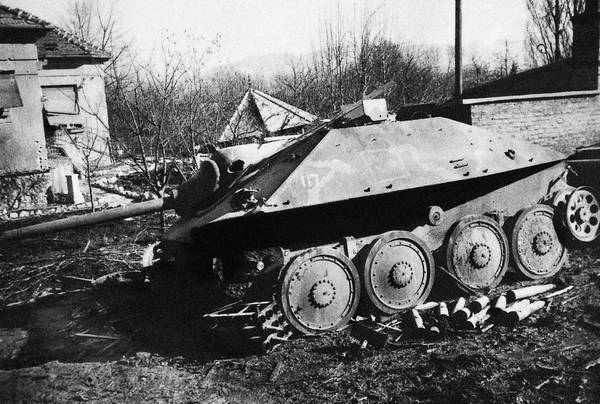
Tank destroyer Jagdpanzer 38 (t) "Hetzer", shot down in the suburbs of Budapest. February 1945 of the year
Articles from this series:
Part 1. Storm and Budapest capture
Part 2. Breakthrough "Attila Line". The beginning of the Pest assault
Part 3. Fall Pest. The beginning of the storming of Buda
Part 4. Strong assault on Buda
Part 5. Operation "Conrad"
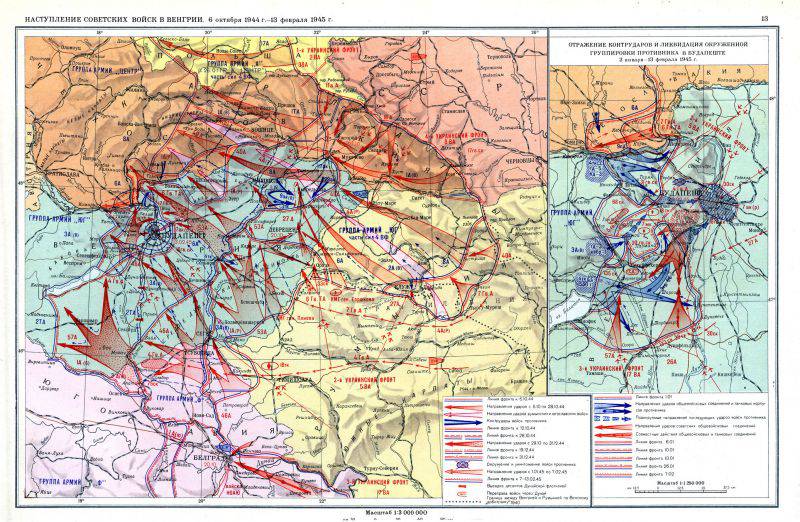
Information